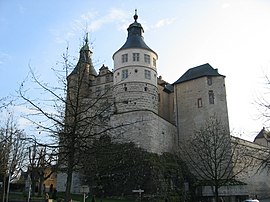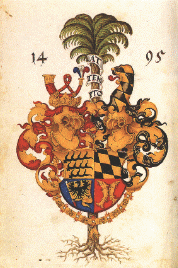Montbéliard
Montbéliard | |
|---|---|
 Château de Montbéliard | |
| Country | France |
| Region | Bourgogne-Franche-Comté |
| Department | Doubs |
| Arrondissement | Montbéliard |
| Canton | Montbéliard-Est and Montbéliard-Ouest |
| Intercommunality | Pays de Montbéliard |
| Government | |
| • Mayor (2014–Present) | Marie-Noelle Biguinet |
| Area 1 | 15.01 km2 (5.80 sq mi) |
| Population (2012) | 26,084 |
| • Density | 1,700/km2 (4,500/sq mi) |
| Time zone | UTC+01:00 (CET) |
| • Summer (DST) | UTC+02:00 (CEST) |
| INSEE/Postal code | 25388 /25200 |
| Elevation | 311–454 m (1,020–1,490 ft) |
| 1 French Land Register data, which excludes lakes, ponds, glaciers > 1 km2 (0.386 sq mi or 247 acres) and river estuaries. | |
Montbéliard[1] (French pronunciation: [mɔ̃beljaʁ]; traditional Template:Lang-de) is a city in the Doubs department in the Franche-Comté region in eastern France, about 13 km (8 mi) from the border with Switzerland. It is one of the two subprefectures of the department.
History
Montbéliard is mentioned as early as 983 as Mons Beliardae. The County of Montbéliard or Mömpelgard was a feudal county of the Holy Roman Empire from 1033 to 1796. In 1283, it was granted rights under charter by Count Reginald. Under its charter, the county was guaranteed perpetual liberties and franchises which lasted until the French Revolution in 1789.
Montbéliard's original municipal institutions included the Magistracy of the Nine Bourgeois, the Corp of the Eighteen and the Notables, a Mayor, and Procurator, and appointed "Chazes", all who participated in the administration of the county as provided by the charter. Also Under the 1283 charter, the Count and the people of Montbéliard were required by law to defend Montbéliard, while citizens of Montbéliard were not required to fight in any wars outside of the county. Altogether, the charter lent to Montbéliard, a democratic air remarkable for its time.
In 1397 the county passed by marriage of Henriette, heiress of county to Eberhard IV, Count of Württemberg, to the House of Württemberg .
In 1520, Duke Ulrich of Württemberg was ousted from the duchy by the Swabian League. As a result, he retreated to Montbéliard, the only territory he still possessed. From there on, Ulrich used Montbéliard as a base of operations to raise troops to retake Württemberg, but in dire need of funds, he decided to lease Montbéliard to his half-brother, George. In 1534, still in need of funds, Ulrich simply sold Montbéliard to Francis I of France, though with right to repurchase, which Ulrich exercised after his restoration to Württemberg in 1536. Still governing Montbéliard as its count, George attempted to strengthen Lutheranism in the county, eventually succeeding in suppressing the other confessions fully.
From 1598 to 1608, the architect Heinrich Schickhardt built several landmarks of the city, like St. Martin, a castle, a bridge, a college and several hotels.
After the French Revolution, Montbéliard was briefly incorporated into the Rauracian Republic.[citation needed] In 1793 the town was annexed to France, which was confirmed in 1796 and by the German Mediatisation of 1806, when Württemberg was compensated with other areas, and became a kingdom.
As a consequence of the former rule under the dukes of Württemberg, it has been for centuries one of the few Protestant enclaves in France. The Württemberg coat of arms from 1495 represents Montbéliard as two jumping fishes on a red field.[2]
Population
| Year | Pop. | ±% |
|---|---|---|
| 1962 | 21,699 | — |
| 1968 | 23,908 | +10.2% |
| 1975 | 30,425 | +27.3% |
| 1982 | 31,836 | +4.6% |
| 1990 | 29,005 | −8.9% |
| 1999 | 27,570 | −4.9% |
| 2008 | 26,207 | −4.9% |
| 2012 | 26,084 | −0.5% |
The metropolitan area has a population of 302,000 (with the city of Belfort).
Administration
| List of mayors | ||
|---|---|---|
| Period | Name | Political party |
| 1947–1957 | Lucien Tharradin | RPF |
| 1959–1965 | Jean-Pierre Tuefferd | PS |
| 1965–1978 | André Boulloche | PS |
| 1978–1989 | André Lang | PS |
| 1989–2008 | Louis Souvet | UMP |
| 2008–2014 | Jacques Hélias | PS |
| 2014-? | Marie-Noelle Biguinet | UMP |
| The previous data are unknown. | ||
Economy


Montbéliard and the surrounding region constitute an important manufacturing center mainly based upon metallurgy and car industry.
The main manufacturing plant of the Peugeot automobile company is partly located in Montbéliard and has around 20,000 employees. In the area the automotive industry accounts for 34,000 employees in more than 100 companies. The Peugeot company's museum is located in the adjacent commune of Sochaux.
Montbéliard is the center of the 'Pays de Montbéliard', a metropolitan area of 132,000 inhabitants.
Main sights
- The Château de Montbéliard, the castle of the Dukes of Württemberg.
As the residence of the Counts of Montbéliard, the history of the castle is closely linked with the story of the families that reigned over the County for more than eight centuries. Built on a rocky promontory at the confluence of the Lizaine and Allan valleys, this stronghold, which already existed in the 10th century, was constantly transformed during the course of the centuries. Today, on the northern side of the edifice, one can admire the Henriette Tower (reconstructed by Countess Henriette in approximately 1424), the Frédéric Tower (1572 and 1595) and the main building dating back to the 18th century. The castle has become the Museum of the Castle of the Dukes of Württemberg, which includes a historical tour, an important archaeological department whose collections come mainly from excavations of local Gallo-Roman sites, the Cuvier natural history gallery and exhibits of paintings and sculptures of international renown. On the esplanade of the Castle, the Clock pavilion or Hôtel du Bailli (Bailli's quarters, also known as the gentlemen's quarters), built according to plans of the architect Schickhardt at the beginning of the 17th century, houses today the Academy of Music.
The Beurnier-Rossel mansion, located opposite St. Martin's church, near the Town Hall, stands as a witness to the life-style of the urban bourgeoisie during the 18h and 19th centuries. Today it houses the Museum of Art and History. The restored 18th century reception rooms on the first floor contain furniture, paintings, chandeliers and draperies which recreate the ambiance of a private residence. On the second floor, there is an exhibit of objects relating to the history of the town and local life (bibles, liturgical vessels, traditional headdresses etc.) and the collection of music boxes made by L'Épée is exhibited in the attic.
Saint Martin Protestant Church was built between 1601 and 1607 and is the work of Heinrich Schickhardt, the architect of Frederic 1st Prince of Montbéliard, in its purest form. It is also the oldest church in France dedicated to the Reformation form of worship.
Built between 1850 and 1875 on the Cardinal Mathieu's request to assert the Catholic reconquest over Lutheranism, Saint Maimboeuf Church dominates the town. Rich façade adornments and polychrome altarpiece. Worth seeing: its never-ending spire.
Sport
Montbeliard's most popular sports club is FCSM (Football Club Sochaux-Montbéliard). Founded in 1928, FC Sochaux-Montbéliard was a founder member of the French professional Football League. The club has played a record 62 seasons in Ligue 1, the most of any club in the French football league system. This consistency contributed to the fact that FCSM, though a small club, has won all the possible national trophies.
FC Sochaux-Montbéliard Honours :
- League Champions of France in 1935 and 1938
- League Runners-up in 1937, 1953 and 1980
- Champions of the French Second Division in 1947 and 2001
- French Cup winners in 1937 and 2007
- French Cup Runners-up in 1959, 1967 and 1988
- League Cup winners in 2004
- League Cup Runners-up in 2003
- Coupe Drago (former French League Cup ) winners in 1953, 1963 and 1964
- Seven times UEFA Cup participations, with the best result as semi-finalists in 1980/1981
- Coupe Gambardella (National Youth Cup ) winners 1983 and 2007
- Third Division Champions in 1987 (Reserves)
Personalities
Montbéliard is the birthplace of:
- Nicolaus Taurellus (1547–1606), philosopher and theologian
- Nicolas Tournier (1590-ca. 1638), painter
- Wolf Christoph Zorn von Plobsheim (1655–1721), architect (de:Wolf Christoph Zorn von Plobsheim)
- Georges Frédéric Parrot (1767-1852) First rector of the University of Dorpat, now University of Tartu.
- Georges Cuvier (1769–1832), naturalist and zoologist
- Alexander of Württemberg (1771-1833)
- Frédéric Cuvier (1773–1838), zoologist and physicist
- Henri Mouhot (1826–1861), naturalist
- René Thom (1923–2002), mathematician
- Dominique Voynet (1958–present), Green politician
- Frank Darabont (1959–present), American filmmaker
- Adrien Mörk (1979–present), golfer
- Pierre-Alain Frau (1980–present), footballer
- Eric Deloumeaux (1973–present), footballer
- Camel Meriem (1979–present), footballer
- Ousame Sy (1988–present), footballer
International relations
Montbéliard is twinned with:
 Greensboro, North Carolina, USA
Greensboro, North Carolina, USA Ludwigsburg, Germany
Ludwigsburg, Germany

